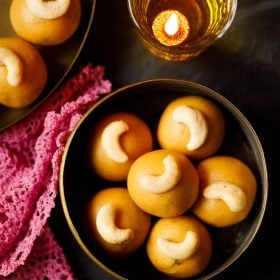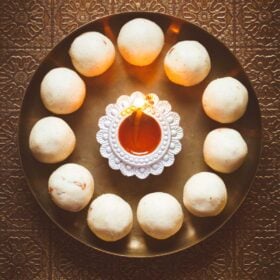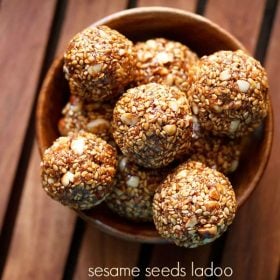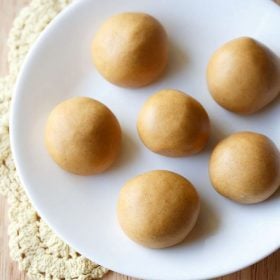Pinni Recipe (Pinni Sweet)
One of the ultimate winter delicacy of the versatile and robust Punjabi cuisine, Pinni is a delicious sweet made of simple and basic ingredients like whole wheat flour (atta), sugar, ghee, nuts and some flavorings. As funny as it sounds, one of the reasons this sweet is called so, is the fact that it is round in shape. Follow this Pinni Recipe of mine, make it at home and enjoy it with your family and friends. Not just a treat for your taste buds, this sweet provides a good source of energy and essential nutrients to your body as well.

What is Pinni
Pinni is a traditional sweet from Punjab, a state in North India. Made with whole wheat flour or atta, dry fruits and nuts, sugar, ghee (clarified butter) and optional edible gum (gond in Hindi), it is one of those desserts or sweets that is perfect for the winters.
A typical Pinni Recipe includes this well roasted golden atta mixture that is shaped into oblong or round balls and stored in air-tight jars.
As much as it is loved during the winter season, it is also a well-known and beloved treat prepared during festivals and special occasions as well.
Because of the ingredients like ghee, dry fruits and nuts that are believed to provide warmth and energy during the cold season, Pinni is a favorite sweet during the chilly season, not just in Punjab but also other parts of North India.
While the basic ingredients of a Pinni Recipe have the ones listed above, different regions of Punjab and other states may have their own unique variations.
These variations could include differences in ingredients, proportions and preparation methods, adding to the diversity of this sweet.
Some recipes may include ingredients like sesame seeds, poppy seeds, coconut and different types of nuts, adding unique flavors and textures. It can also not only be made with atta, but also with types of lentil flours, millet flours and ground seeds & nuts powders.
You can combine these flours and powders with whole wheat flour as well. All in all, you absolutely must give this recipe a try, if you are a lover of all things sweet and lovely.
About This Pinni Recipe
In this post, I’ve shared our family Pinni Recipe, similar to Atta Laddu but with the addition of edible gum (gond). Feel free to explore the Gond Laddu recipe on the blog as well.
We do make this sweet in bulk (and even Panjiri) to be enjoyed throughout the cold winter months. However, for the blog, I made the same recipe with less proportions.
To make this Pinni recipe, an absolute essential ingredient that you require is atta, which is ground whole wheat flour used to make roti or chapati in the Indian subcontinent.
Here, you must keep in mind that this atta is different from the whole wheat flour available in countries outside India.
Atta is made with hard or semi-hard durum wheat that is ground with the help of stone grinders. On the contrary, the western whole wheat flour is usually made with red wheat that is softer as compared to durum wheat and ground using steel rollers.
Also, in the Pinni Recipe of our household, edible gum or gond is added. This unique and special ingredient, along with the crushed nuts, gives a nice crunch to the sweet. However, you can opt to omit the edible gum in case of non-availability or if you do not wish to add.
Make sure that you are using desi ghee to make the recipe of Pinni. Although, the sweeteners can be of your choice. We always use khand (unrefined sugar) or powdered sugar.
You can opt to use jaggery or coconut sugar or palm sugar or powder the regular white sugar and add instead. Whichever sweetener you use, add according to taste.
One of the most common spice flavorings in a Pinni Recipe is that of green cardamom powder. Even, I add it along with dried ginger powder (saunth). You can choose to skip both these, if you wish to.
Step-by-Step Guide
How to make Pinni
Prep Gond & Nuts
1. Place a kadai (wok) or frying pan on medium to medium-high heat and add 3 tablespoons desi ghee in it. Ensure the ghee reaches around 180 degrees Celsius for optimal frying of gond (edible gum).
If the temperature is too low, the gond won’t puff up and may remain raw. Add a small piece of gond to test; it should puff up immediately.
When the ghee is moderately hot, add 2 tablespoons gond and begin to fry.
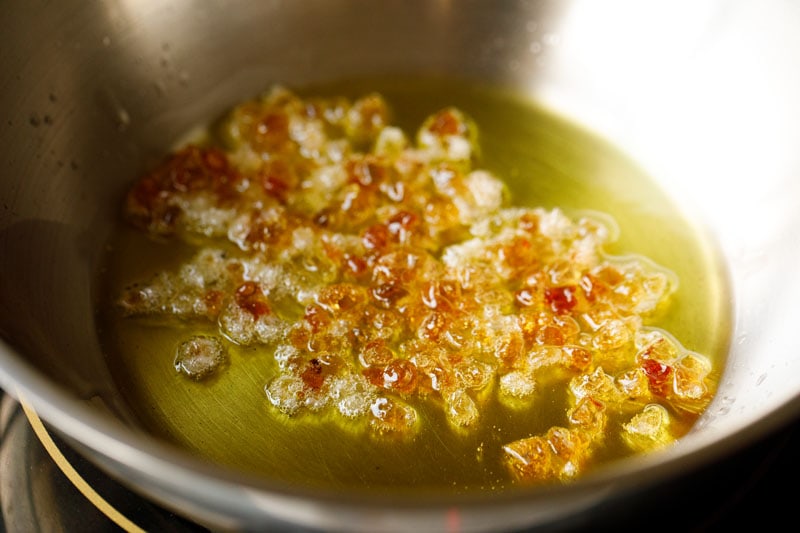
2. Fry the gond pieces till they puff up and achieve a light golden color, ensuring they are well and evenly fried. Keep stirring continuously for uniform results.

3. Ensure that the gond is thoroughly fried with a light golden color and puffed well.
It’s crucial to avoid any raw, uncooked center, as this firm, uncooked part may adhere to the teeth during consumption.

4. Use a slotted spoon to remove the fried gond and place them on kitchen paper towels, allowing excess ghee to drain.
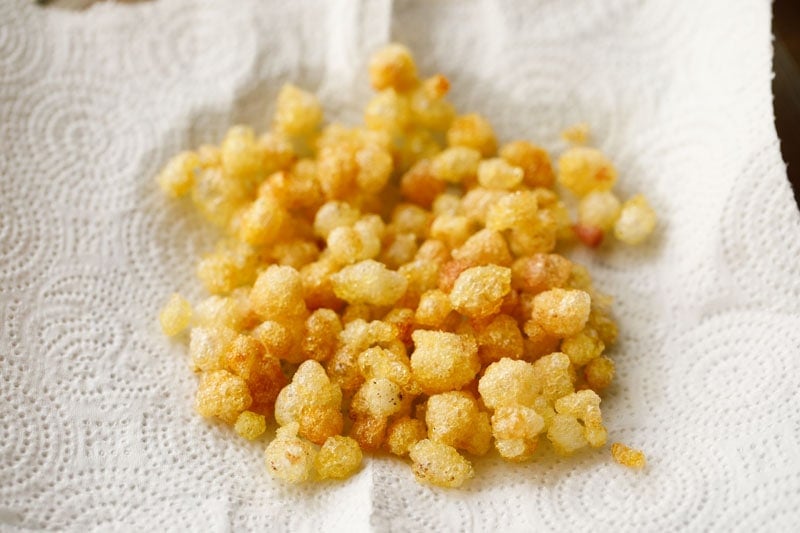
5. Lower the heat to low or medium-low, add 2 tablespoons almonds and fry for one minute or so until there’s a noticeable change in color. If necessary, you can increase the heat to medium.
Use a slotted spoon to take out the almonds and place them on kitchen paper towels to drain.
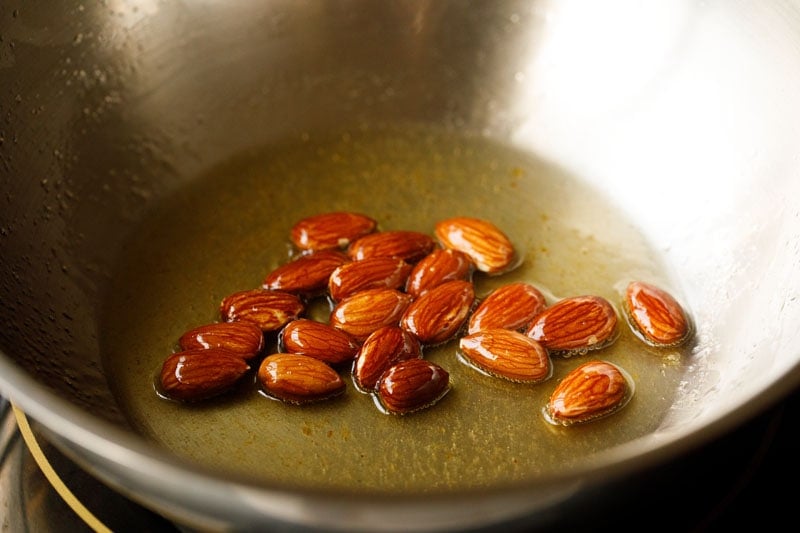
6. Fry 2 to 3 tablespoons cashews until they achieve a light golden or golden color.
If necessary, increase the heat to medium and adjust the time accordingly. Once done, remove them and place on kitchen paper towels to drain.

7. Next, fry 2 tablespoons pistachios for about a minute or until their color changes to light golden.

8. Turn off the heat. Subsequently, remove the pistachios and place them on kitchen paper towels to drain.
Placing the fried nuts on kitchen paper towels serves the purpose of absorbing any excess ghee, ensuring that the nuts are well-drained and ready for the next steps in this recipe.

Powder Gond & Nuts
9. Allow the fried gond and nuts to cool. Once they reach room temperature, you can grind them.
Optionally, the gond can be powdered using a mixer-grinder, mortar-pestle, rolling pin, or the back of a small steel bowl or glass. Crush the gond on a plate with a steel bowl until finely powdered.
Alternatively, you can use the small chutney grinder of your mixer-grinder, similar to what I do, to finely powder the gond.
Transfer the fried gond to the mixer-grinder. Powder it finely and set aside.
When grinding, it’s essential not to grind continuously. Instead, pulse in short spurts of a few seconds.
You can also utilize the pulse option on your mixer-grinder. Remember to scrape the sides intermittently and grind in short bursts to achieve a fine powder consistency.
This method helps prevent overheating and ensures that the fried gond is ground finely without compromising its quality.

10. In the same grinder, add the fried almonds, cashews and pistachios.
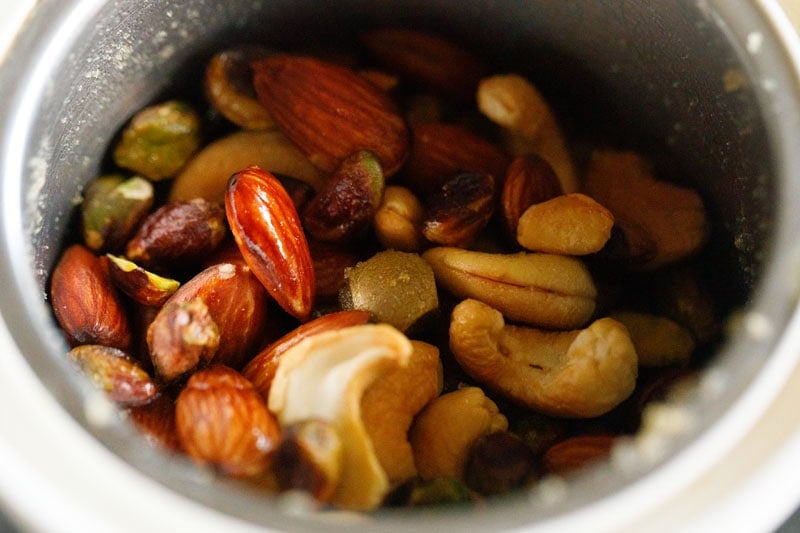
11. Grind the nuts, and this time too in short intervals to get a coarse or semi-fine texture.
Feel free to grind it to a finer consistency, if that’s your preference.

12. Sift 0.75 cup/ ¾ cup of powdered sugar to remove lumps. Set aside.
Sifting powdered sugar aids in eliminating small blocks or lumps of sugar that may not blend well with the roasted flour. This step ensures a smoother and more homogeneous mixture.
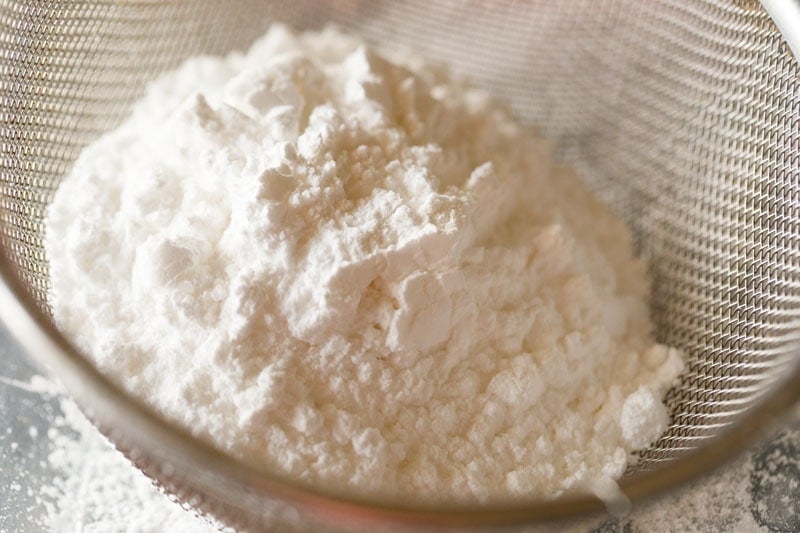
Roast Whole Wheat Flour
13. Approximately ½ tablespoon of ghee will be present in the pan or kadai after frying the nuts.
Heat the kadai over medium-low heat, allowing the ghee to become warm or reach a lightly hot temperature. Add 1 cup whole wheat flour afterwards.

14. Mix so that it thoroughly combines with the ghee.

15. Roast the flour for 8 to 10 minutes or until fragrant. In the picture below, you can see how the flour appears after roasting for 8 minutes.
The duration for roasting the flour may vary depending on factors such as the material, size and thickness of the pan.
In my case, I used a steel kadai without a thick-bottomed base, and it took approximately 8 minutes to achieve the desired level of roasting.
It’s essential to be attentive to these variables to ensure the flour is roasted to the desired extent.
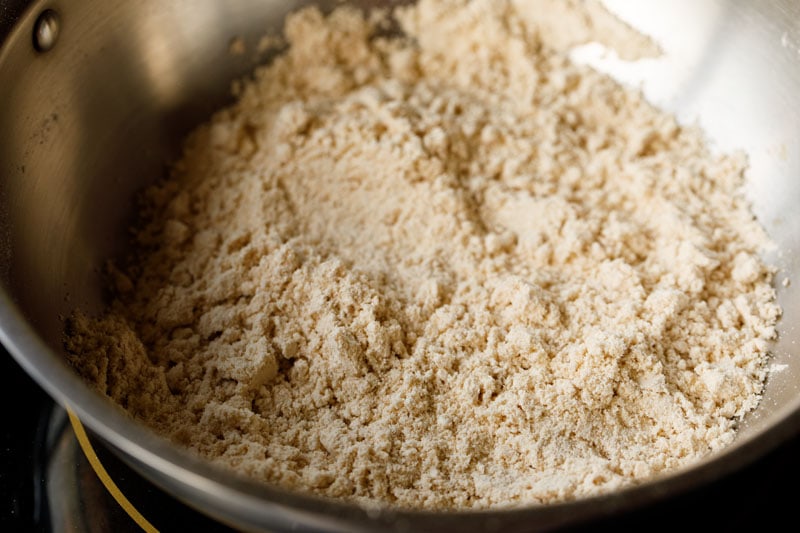
16. Now, add 4 tablespoons desi ghee.

17. Mix the ghee thoroughly with the flour.
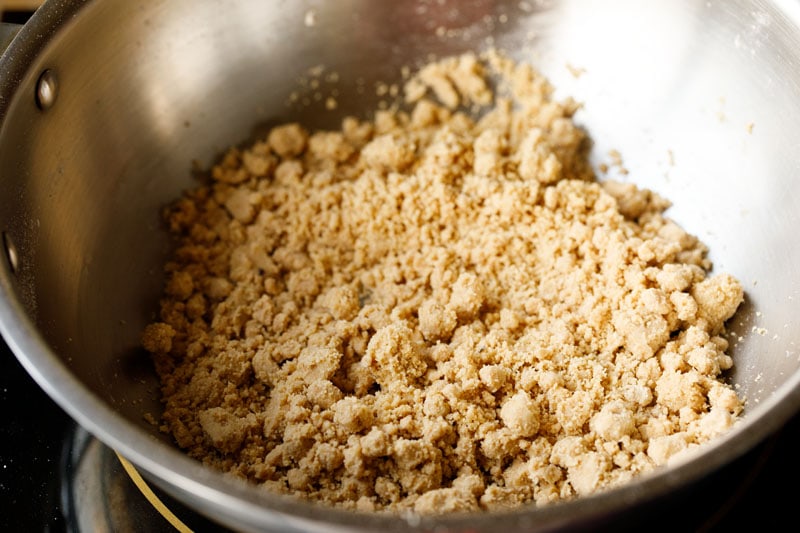
18. Continue stirring and roasting the mixture for 4 to 6 minutes more. Keep in mind that the timing may vary depending on elements such as the material, size, volume, and thickness of the frying pan or kadai (wok).
In my case, using a steel kadai, it took about 6 minutes to complete this roasting step. Adjust the duration accordingly to achieve the desired texture and flavor.
You can evaluate the doneness using your senses. Look for an even golden brown color and inhale the fragrant nutty aroma of the roasted whole wheat flour.
These cues will help you determine when the flour has reached the desired level of roasting as shown in the picture below.
Also, check the taste of the whole wheat flour; it should exhibit a cooked nutty flavor without any hints of rawness.
This step ensures that the flour is thoroughly cooked which contributes to the overall quality of this traditional sweet.
The total roasting time for the flour varies approximately between 12 to 16 minutes, depending on factors such as flour texture, quality, pan thickness, and material type.

Make Pinni
19. Turn off the heat and place the kadai (wok) on your kitchen countertop. Add the powdered gond & nuts, 1 tablespoon raisins, sifted powdered sugar, ½ teaspoon green cardamom powder and ½ teaspoon ginger powder.

20. Mix thoroughly with a spoon to get an even mixture.
Do a taste test, adjusting sugar, if required.
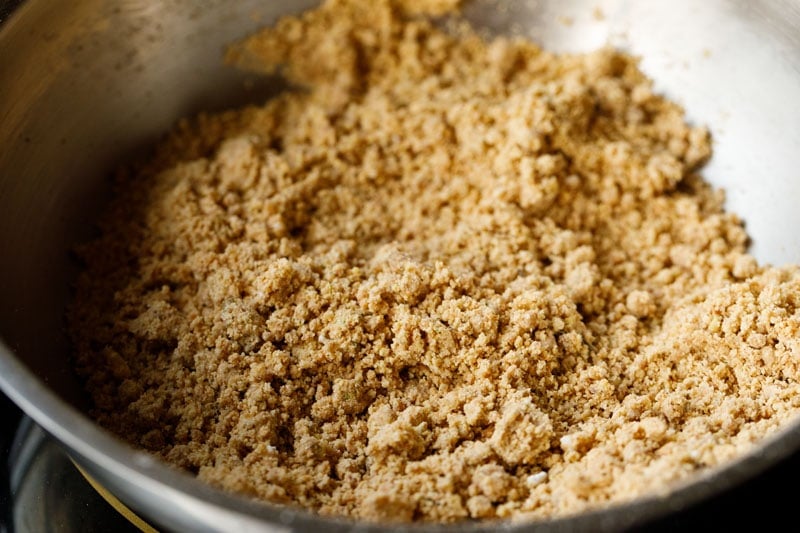
21. While still hot, shape portions of the mixture into round Pinnis. While I’ve rolled them into a ladoo form, you have the option to press the portion in your fist to create small oblong or cylindrical shapes, which will bear the impression of your fingers.
If the heat becomes intolerable, wait for a few minutes. It’s important not to risk burning your hands. Remember, once the mixture cools, shaping becomes difficult as the mixture becomes hard.
If forming tidy round balls proves difficult and the mixture is crumbling, incorporate a few additional tablespoons of warm ghee. Mix thoroughly and then proceed to form the round balls.

22. Serve Pinni or store at room temperature in an air-tight container.
These keep well for a months, especially during the cold winters of North India. Storing in an air-tight container helps preserve its freshness and prevents it from becoming overly dry.
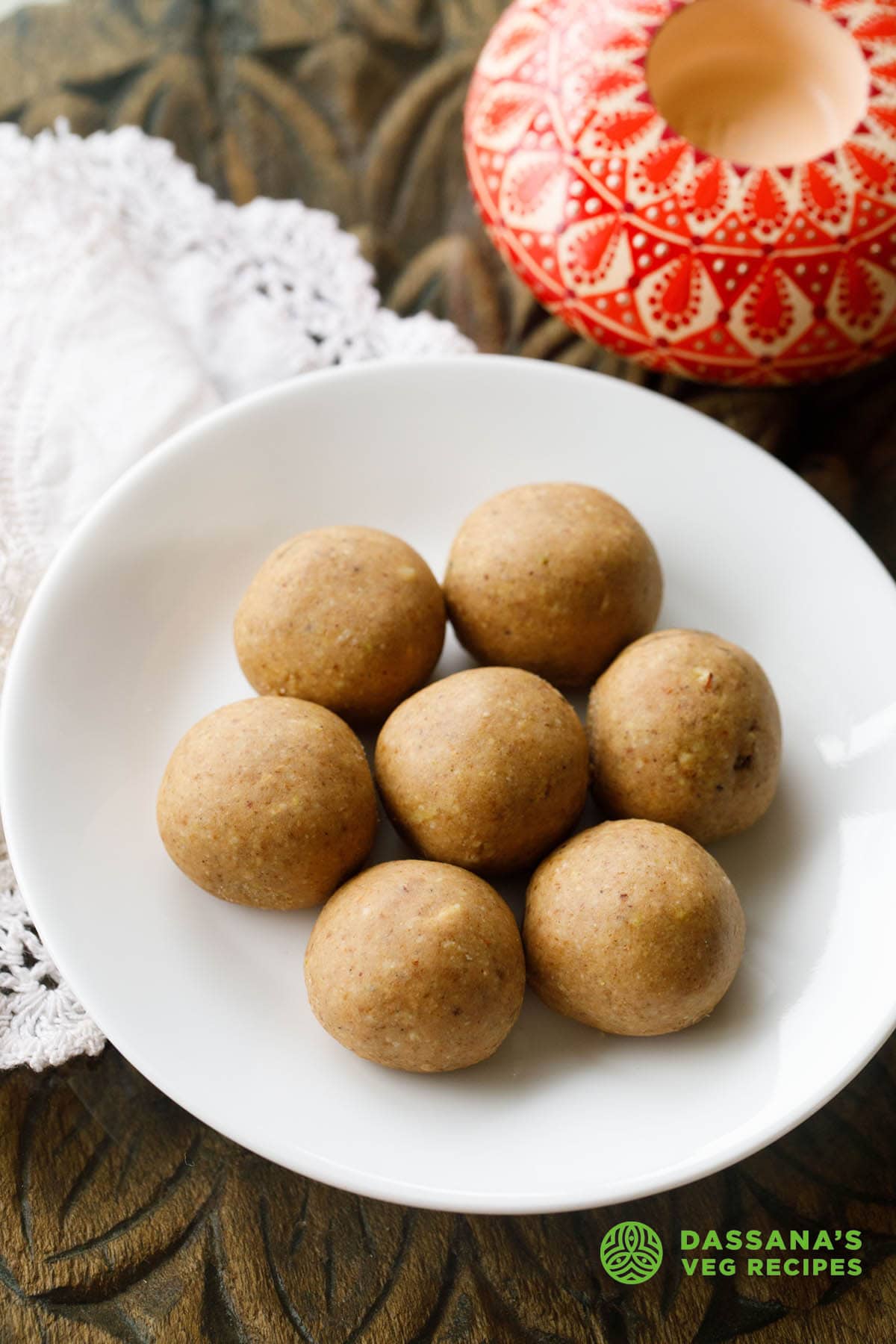
Serving Suggestions
There are number of ways you can experiment with, in serving Pinni. According to the different occasions or preferences, you may choose to select any of the below listed ways of presentations too.
- Simply Sweet: Enjoy this dish like a sweet delight, by its own during a festival, as a post-meal dessert or in just about any special celebration in your home.
- A Snacky Sweet: You can prepare the Pinni Recipe, pair it with hot milk and consume like a morning/breakfast or evening snack. A great option for children too, as it makes for a wholesome, nourishing combination.
- For Festivities: This sweet happens to be one of the original choices during many festive or special occasions. Since it is a homemade goodness, it will add a personal touch to the celebrations.
- For Gifting Purposes: Pack these homestyle sweets in fancy jars or boxes and gift them to your loved ones. These make for wonderful gifts and hampers during festivals.
Pinni Variations
Like I said earlier, there are numerous possibilities to make your own Pinni Recipe. Here are some of the ways that you can try at the comfort of your home.
- Flour: Other than whole wheat flour or atta, pearl millet (bajra) flour, barley flour, sorghum (jowar) flour, finger millet (ragi) flour, semolina flour (suji), besan (gram flour), urad dal flour or even a combination of these can be used to make a unique tasting Pinni.
- Sweeteners: Alternatives to conventional sugar are palm sugar, coconut sugar and jaggery. However, according to the intensity of sweetness of the sweetener chosen, you will have to vary the proportions. Adjust and add gradually, as per the level of sweetness you want in the dish.
- Spice: Cardamom, ginger, nutmeg and cinnamon – all of these work well in this recipe, and bring in a hint of warmness and aroma in the sweet.
- Nuts: Almonds, pistachios, cashews et al. Use any one, 2 or a medley of nuts to bring in your choice of texture and flavor in the sweet.
- Coconut: For en enhanced tropical twist in the sweet, consider adding some grated coconut or coconut powder in the traditional recipe.
- Seeds: An extra element of crunchiness can be achieved in the sweet by incorporating sesame seeds, flax seeds or poppy seeds.
- Fruit: Raisins, chopped figs or dates, and other dried fruits are a great way of bringing in a natural sweetness as well as a chewy texture in the dish.
This famous sweet of Punjabi cuisine is known for its versatility. You can explore and make your own tailor-made versions, suiting to your taste and dietary preferences.
Expert Tips
- For best results, use fresh and high-quality flour, ghee, nuts and all other ingredients. Make sure the nuts are not rancid.
- Adding edible gum (gond) is optional. You can skip it if you don’t have it.
- Make sure to roast the flour, slow and steady on low to medium heat. This will ensure even browning and bring in a nice nutty aroma in the sweet.
- To prevent uneven cooking and ensuring a uniform color and texture in the mixture, keep stirring consistently while roasting the flour.
- You will have to adjust the cooking/roasting time as per the type, thickness, material and size of the pan used.
- For an authentic, enhanced flavor in the sweet, try and use desi ghee. This will also make the sweet rich and with a distinctive flavor.
- To eliminate lumps for a uniform blend of the roasted flour, which also ensures a smoother texture in the sweet, you can sift the powdered sugar before adding in the mixture.
- For the perfect taste, taste the roasted flour mixture. It should be cooked with no raw mouthfeel. You might have to adjust the time for this, accordingly.
- Adjust the sugar quantity based on your taste preferences – feel free to decrease or increase. You can also powder white sugar or raw sugar for use in the recipe.
- The Pinni recipe can be scaled up, to accommodate more servings.
FAQs
The basic traditional ingredients of Pinni Recipe include wheat flour (atta), desi ghee, sugar, nuts and some added flavorings. But there are many regional variations too that may include seeds, coconut and different types of flour, nuts or spice powders.
Punjabi Pinni can be a relatively healthy treat when consumed in moderation. It includes nutritious ingredients like whole wheat flour, ghee, and various nuts, providing a source of energy and essential nutrients.
However, its calorie and sugar content should be considered. So, enjoying it as part of a balanced diet is key to maintaining a healthy lifestyle.
Pinni is traditionally enjoyed during special occasions, festivals, and winters in Punjabi culture. It’s a rich and energy-packed treat, making it suitable for celebrations or as a winter delicacy.
Though do remember that moderation is key, and incorporating it into your diet during festivities or colder seasons can be a delightful choice.
More Similar Sweets To Try!
Ladoo Recipes
Ladoo Recipes
Ladoo Recipes
Ladoo Recipes
Please be sure to rate the recipe in the recipe card or leave a comment below if you have made it. For more vegetarian inspirations, Sign Up for my emails or follow me on Instagram, Youtube, Facebook, Pinterest or Twitter.

Pinni Recipe (Pinni Sweet)
Pinni, a cherished winter delight in Punjabi cuisine, is a sweet made with basic ingredients like whole wheat flour, sugar, ghee, nuts, and flavorings. The round shape gives it its name. Try my Pinni Recipe, and enjoy not just a tasty treat but also a good source of energy and essential nutrients.
Prep Time 5 minutes
Cook Time 20 minutes
Total Time 25 minutes
For Frying
More Ingredients
Preparation
Heat 3 tablespoons of ghee in a frying pan or kadai (wok) over medium to medium-high heat.
Ensure ghee is about 170 to 180 degrees Celsius. To check, add a small piece of gond; it should puff up immediately.
When the ghee is moderately hot, add all gond pieces in the frying pan or kadai (wok)
Stir and fry until crispy, golden, and puffed. Keep stirring for even frying.
Use a slotted spoon to remove fried gond pieces. Place the fried gond pieces on kitchen paper towel and let them cool.
Reduce heat to low or medium-low.
Add almonds and fry for about a minute or until their color changes. Increase the heat to medium if needed. Remove fried almonds with a slotted spoon and set aside on kitchen paper towel.
Add cashews and fry for about 1 to 2 minutes or until light golden or golden. Increase the heat to medium if needed. Remove fried cashews and place on kitchen paper towel.
Add pistachios and fry for about a minute or until the color changes and light golden. Turn off the heat. Remove with a slotted spoon and place on kitchen paper towel.
Powdering Gond and Nuts
Let the fried gond and nuts cool at room temperature.
- Once cooled, powder gond using a mixer-grinder or other tools like a mortar-pestle or back of a steel bowl or steel glass. If using a mixer-grinder, grind in short spurts or use the pulse option of your mixer-grinder to get a fine texture. Remove powdered gond and set aside.
In the same grinder, pulse almonds, cashews, and pistachios to make a coarse or semi-fine mixture. Set aside. Opt to make a finely ground texture if you prefer.
Additionally, sift powdered sugar to remove lumps. Set aside.
Roasting Flour
Approximately half a tablespoon of ghee will be left in the pan or kadai after frying the nuts.
In the same kadai or pan, heat this remaining ghee until warm or lightly hot.
Add whole wheat flour. Mix it evenly with the ghee.
On medium-low heat, roast flour for 8 to 10 minutes or until fragrant, stirring often and non-stop.
Once this is achieved, add 4 tablespoons of ghee and mix thoroughly with the roasted flour.
Stir continuously for 4 to 6 minutes or until the flour turns evenly golden.
The overall roasting duration for the flour typically ranges from 12 to 16 minutes, influenced by factors like flour texture, quality, pan thickness, and metal type.
Making Pinni
Turn off the heat. Place the pan or kadai on the kitchen countertop.
Add powdered gond, powdered nuts, raisins, sifted powdered sugar, green cardamom powder, and ginger powder. Mix thoroughly. Do a taste test and add more sugar if needed.
While still hot, take a portion of the mixture and form round pinnis.
Storage and Serving Suggestions
Store pinni at room temperature in an airtight container. Keeps well for about a month in the cold winters of North India.
Enjoy pinni as a sweet treat on their own or paired with hot milk, especially for children.
Customize Your Pinni
- Flour Variety: Experiment with pearl millet, barley, sorghum, finger millet, semolina, gram flour (besan), urad dal flour or a mix for a unique Pinni flavor.
- Sweetener Alternatives: Try palm sugar, coconut sugar, or jaggery, adjusting quantities based on your desired sweetness level.
- Spice Infusion: Enhance your Pinni with cardamom, nutmeg, ginger or cinnamon for warmth and aroma.
- Nut Choices: Opt for almonds, pistachios, cashews, or a mix to tailor the texture and flavor to your liking.
- Coconut Twist: Add grated coconut or coconut powder for a tropical touch.
- Seeds for Crunch: Introduce sesame seeds or poppy seeds for an extra crunch.
- Dry Fruit Inclusions: Raisins, chopped figs, or dates bring natural sweetness and chewiness.
Recipe Notes
- Ensure freshness and quality of ingredients, especially flour, ghee, and nuts.
- Use desi ghee for an authentic, rich flavor.
- You can opt to add edible gum (gond) or leave it out if you don’t have it.
- Sift powdered sugar to eliminate lumps and ensure a smooth texture.
- Modify the sugar amount according to your taste preference – feel free to reduce or increase. You may also use powdered white sugar or powdered raw sugar in the recipe.
- Roast the flour slowly on medium-low to medium heat for even browning and a rich aroma. Consistently stir while roasting for uniform color and texture.
- Adjust cooking time based on pan type, thickness, material, and size.
- Taste the roasted flour mixture to ensure it is cooked without any raw mouthfeel.
- Scale up the Pinni recipe for more servings as needed.
Nutrition Facts
Pinni Recipe (Pinni Sweet)
Amount Per Serving
Calories 101 Calories from Fat 90
% Daily Value*
Fat 10g15%
Saturated Fat 6g38%
Polyunsaturated Fat 0.4g
Monounsaturated Fat 3g
Cholesterol 24mg8%
Sodium 0.3mg0%
Potassium 8mg0%
Carbohydrates 4g1%
Fiber 0.1g0%
Sugar 3g3%
Protein 0.2g0%
Vitamin A 1IU0%
Vitamin B1 (Thiamine) 0.003mg0%
Vitamin B2 (Riboflavin) 0.003mg0%
Vitamin B3 (Niacin) 0.03mg0%
Vitamin B6 0.004mg0%
Vitamin C 0.03mg0%
Vitamin E 0.1mg1%
Vitamin K 0.1µg0%
Calcium 1mg0%
Vitamin B9 (Folate) 0.3µg0%
Iron 0.1mg1%
Magnesium 2mg1%
Phosphorus 4mg0%
Zinc 0.03mg0%
* Percent Daily Values are based on a 2000 calorie diet.

